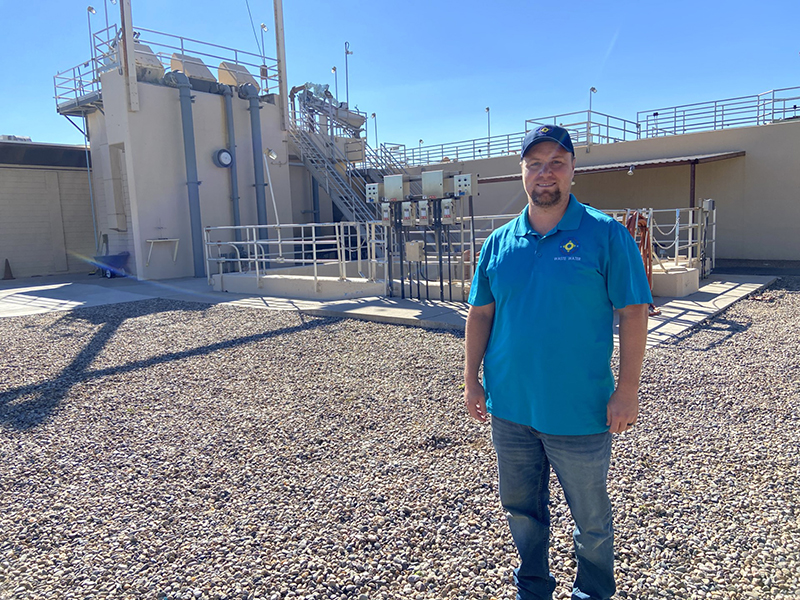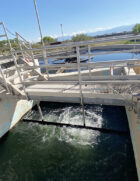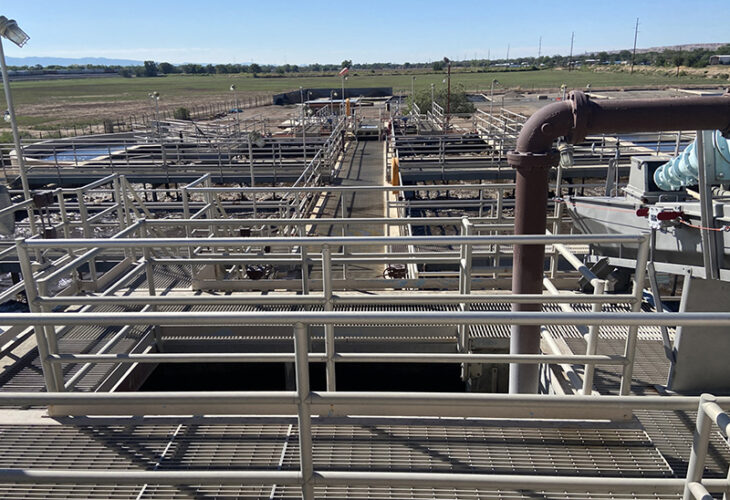BELEN—Have you ever wondered where the water from your home goes after it disappears down the sink or after you flush your toilet?
If you live in a town or city, all of this water flows through the sewer system, ending up at your local wastewater treatment plant to be cleaned and discharged into the river.
Wastewater treatment is the process of converting wastewater into water that can be discharged back into the environment. Its formed by a number of activities, such as bathing, washing, using the toilet and rainwater runoff.

Jeffrey Gatewood, the city of Belen’s wastewater director, and his department is responsible for the collection and treatment of all wastewater within the Hub City.
Jeffrey Gatewood, the city of Belen’s wastewater director, and his department is responsible for the collection and treatment of all wastewater within the Hub City.
As you enter the plant’s grounds near Vivian Fields, it’s clear the city takes pride in the 41-year-old facility, with it’s nicely-manicured lawn and the substantial maintenance of the plant. Earlier this year, the plant received the 2022 Good Housekeeping Award for Activated Sludge Treatment Plant 20 Years and Older from the New Mexico Water and Wastewater Association.
“It’s always nice to be recognized for the hard work we put into it,” Gatewood said.
While the plant looks in tip-top condition, the city council has made upgrading the facility a top priority.
Belen City Manager Roseann Peralta said the city’s engineers have estimated the rehabilitation of the WWTP will cost between $13-$14 million.
“We would like to rehab, expand and replace everything we can in there,” Peralta said. “We received a $2 million appropriation out of this last (legislative) session that will help us with the first phase.”
The city is also seeking other funds, including at the federal level. Peralta said the city has recently been denied congressional direct funding, but they aren’t discouraged.
“We’ll be applying again,” she said. “It is No. 1 on our ICIP.”
According to the city’s Infrastructure Capital Improvement Plan for 2025-29, the city is looking at including a new ultraviolet light disinfection system, general rehabilitation, energy efficiency improvements, process modifications for permit-required nitrogen removal and sludge handling improvements, such as a new sludge dewatering facility. The city also hopes to increase the size of the plant’s lab.
Gatewood, who has been the director for about five years, began his career with the city 14 years ago as a laborer at the WWTP. With perseverance and a consistent desire to succeed, Gatewood continued to be promoted until he was finally named director.
The city’s WWTP is an advanced activated sludge extended aeration system.
“We use air to supply oxygen to the microorganisms that break down the sludge and treat the process,” Gatewood said. “We use blowers that supply air to the plant.”
What comes into the plant via the city’s 17 lift stations from the gravity sewer conveyance system is what can only be described as dirty water, Gatewood said.
“It’s pumped into the system, goes through some filtration with a bar screen rake, which gets rid of any excess debris that shouldn’t be in the system,” the director explained.
The next step in the process is going through a grit chamber, which is a long, narrow or circular tank that removes inorganics that won’t break down, such as sand and eggshells.
Here, the influent passes through the fine screens to remove items that shouldn’t have found their way down the drain or toilet in the first place. This includes items such as wipes, paper towels, feminine hygiene products and more.
Gatewood said after the wastewater leaves the grit chamber, it’ll then be sent to the aeration basin, where the air is provided to the microorganisms which feed off the waste.
Next, the aerated wastewater, along with the bacteria and microorganisms, flow to the final clarifying tanks. The large, circular tanks allow the microorganisms to be separated from the clean water by settling to the bottom of the tanks.
Most of these microorganisms are recycled back to the aeration tanks to clean more water; the rest are continuously cycled out of this process to make way for new, hungry microorganisms. The retired microorganisms aren’t wasted though.
In the process of cleaning the water, they take nutrients, such as phosphorus, out of the water. These nutrients are problematic if they stay in the water, but on land, they help things grow.
Once the water leaves the final clarifiers, it has completed secondary treatment, and is now called effluent, which is cleaned wastewater.
At the end of the process, the leftover sewage sludge, which contains essential nutrients for plants and is potentially a very beneficial fertilizer. Gatewood said the compost is given to Rasband Dairy to use in the alfalfa fields.
“The process is ongoing — 24/7,” Gatewood explained. “We have an alarm system that will notify us if anything out of the ordinary happens — if a machine shuts down. There’s someone on call that will respond to it.”
A WWTP is a critical component to the city’s infrastructure, Gatewood explained, saying its a way to “keep the world healthy, and trying to provide clean water for the future for aquatic life.”
The Belen Wastewater Treatment Plant was built in 1982, a state-of-the-art facility back then. While the city was a bit smaller back then, Gatewood said it served as a blueprint for other plants in the state.
“It definitely needs an upgrade — it needs help,” he said. “There’s pumps and other mechanical stuff that have certain life spans. They’ve used their life up, and even though they’re still running, they need to be replaced.”
Gatewood said the facility is in desperate need of the upgrades, especially with the U.S. Environmental Protection Agency’s new requirements, including getting more nutrients out of the system. He also said the city is looking to switch from the typical chlorine treatment to ultraviolet disinfection.
Because effluent is returned to surface waters where people could come into contact with the water, the water would undergo an additional process of ultraviolet disinfection. The effluent would pass through high-strength UV lights designed to deactivate disease-causing bacteria before the water is sent to the river.
“We need to upgrade the blower system, as well as the air diffusers,” Gatewood said. “We want to switch from drying beds to a dewatering system and a screw press, which compresses the sludge and water.”
The staff of eight at the Belen Wastewater Treatment Plant includes a lab tech, who is responsible for testing. The prime function of a wastewater laboratory facility is to ensure that all discharges from a control facility meet all appropriate federal and state standards.
Gatewood said the lab tech runs many tests, including biochemical oxygen demand, total suspended solids and for total residual chlorine to make sure they’re not using too much. They also regularly test for E. coli.
“These are tests we have to do for our permit — our NPDES (National Pollutant Discharge Elimination System) permit, which is our permit to discharge into the Rio Grande,” Gatewood said. “Some tests we have to do every day, others are done weekly.”
Maintaining the plant has become more challenging over the years, the director explained, as the equipment has aged significantly.
With Belen growing now more than it has in the last several decades with both residential and commercial development, Gatewood said the WWTP is holding steady.
Belen’s plant has a maximum capacity of 1.2 million gallons a day; however, the facility currently averages about 600,000 gallons a day.
“If we ever got to that amount (1.2 million) or over, then we’d have to expand and have a higher capacity,” Gatewood said. “Right now, we have room for new businesses and residents to move in and we will still be good.”
With the recent increase in the number of homes within two new subdivisions in the Hub City, the WWTP director said there hasn’t been a significant increase at the plant.
“It just depends on usage,” he said. “An average household uses about 60 to 70 gallons of water per day — that’s taking showers, going to the bathroom, doing dishes, doing laundry.”
Wastewater treatment is vital for healthy communities and ecosystems. Gatewood said while a lot of people don’t know about the local facility much less what it entails.
“It’s a very important piece of our city,” he said. “What would happen if you flush your toilet and it goes down but doesn’t go anywhere to be cleaned.”
Clara Garcia is the editor and publisher of the Valencia County News-Bulletin.
She is a native of the city of Belen, beginning her journalism career at the News-Bulletin in 1998 as the crime and courts reporter. During her time at the paper, Clara has won numerous awards for her writing, photography and typography and design both from the National Newspaper Association and the New Mexico Press Association.




















